This project will take around 7 years of preparation and 42 hours of labor. Choose your inspiration wisely, then make sure to work with a professional for guidance, troubleshooting, advice and assistance. 1
Gather your materials. In our case we will be using recycled white gold, a few flecks of rose gold and a Moissanite 2 gemstone.
Making the band
 Anneal the long bar with an oxy-propane torch to make it more pliable. Once you’ve annealed it, take it to the bending machine and work it into a circle.
Anneal the long bar with an oxy-propane torch to make it more pliable. Once you’ve annealed it, take it to the bending machine and work it into a circle.
Once the bar is bent into a circle, place the circle on an anvil with the crack at the top. Â Hit the ends gently with a small hammer to fold them in on themselves. Â There will still be a small V shaped notch.
To close the notch, use a fine jeweler’s saw to cut through the very middle of the notch. Â A few more bangs on the ends and they should close up.
Close and round the band
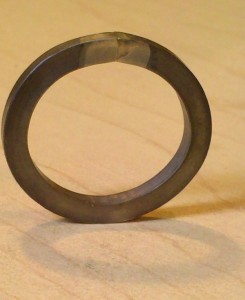 Now solder the band closed. Â Cover the band with flux paste. Â This flux paste keeps the ring from being discolored by oxidation, etc. during the annealing process. Â Clamp the ring in a helper and then put a chip of white gold solder on the crack. Â Use a torch to heat the band until it begins to glow, heating evenly all over. Â As soon as the solder liquefies, capillary action should draw it into the crack. Immediately take the heat away. Â Quench the ring and put it back in the heated pickle 3 to dissolve the flux.
Now solder the band closed. Â Cover the band with flux paste. Â This flux paste keeps the ring from being discolored by oxidation, etc. during the annealing process. Â Clamp the ring in a helper and then put a chip of white gold solder on the crack. Â Use a torch to heat the band until it begins to glow, heating evenly all over. Â As soon as the solder liquefies, capillary action should draw it into the crack. Immediately take the heat away. Â Quench the ring and put it back in the heated pickle 3 to dissolve the flux.
This is the time to round out the ring. Â Put it on a mandrel to check the size. Â Hammer with a leather hammer until the ring is circular and the correct size.
File away at the surface of the ring to get rid of any oxidation.
Now this is a single formed band. Â Some wedding bands end here and just go to being rounded and polished. Â This engagement ring is much more complicated.
Making the gem setting
To form a smooth transition to the gem setting, take a leftover waste section of the bar, roll it out to thin it. Then bend it on the bending machine so that the arc matches the outside arc of the ring. Hammer at it on a mandrel to thin out the ends.
Paint the ring and the arc with flux, then wire them together. Solder the two pieces together to form one.
Time to make the gem setting.  Use the flat piece of white gold bar and roll it into a loop.  Put the loop in a setting punch – in this case an oval one.  The setting punch has an oval punch that matches – this presses the gold into a nice oval tapered cup. The ring needs a place for this cup to sit. Use a fine jeweler’s saw to cut out a wedge from the ring and then grind away with a dremel-style tool till the ends of the ring match the sides of the cup. Finish with a half round file to ensure a smooth fit.
Solder them together.
Now it is time to smooth out the transition from the ring to the setting. This will take forever and is done with a dremel tool for the course work and is finished with a file. Finally, fill in the concave section of the transition with chips of gold. For this ring, use rose gold chips. Clamp the ring at an angle when heating so that the rose gold falls into the right spots of the ring. This part must be done quickly or the bottom of the ring will heat too much and the rose gold on the underside will drip off.
With the rose gold blazes in the setting transition done, shape and grind the ring. Remove material from the sides to thing them for comfort. Round off all of the edges. Curve the inside of the gem setting so it doesn’t grate or rub against a very important finger. Begin polishing the band and setting. The rest of the polishing will take place after the gem is set.
Setting the gem
Cover the band in thermoset plastic and secure it in a ball clamp 4. Now use a dremel tool to carve a thin seat in the setting cup. It should be deep enough to let the gem sit securely, but not so deep that it will scratch the finger.
With a jeweler’s saw, cut away a symmetrical rhomboid to expose a floating setting – this means the gem is sitting only on the raised seat and light can go through the sides of the stone. With a small hammer and chisel, tap the edges over to keep the gem secure against the seat. Go very slowly. A wrong tap could chip the gem. Examine the setting with a loupe after every few taps to make sure the gem is level.
Polish
Drop the ring and thermoplastic into hot water and peel off the plastic gunk. Buff the ring with increasingly finer abrasive and papers. Thoroughly wash the ring to remove any grit or abrasive.  Hold the ring only with soft strips of leather and buff it against what looks like the world’s fastest shoe polisher. Take pictures to eventually show this beautiful ring to friends near and far.
Present
Find the sweetest most perfect partner for the rest of your life and present a tiny little symbol of love and commitment. Begin planning the next rings and the wedding.
- Sam Abbay of New York Wedding Rings is a pleasure to work with and I can’t recommend him enough. He makes sure that all materials are sourced ethically and safely. He gives great advice and helps you through the most difficult bits. The ring I made with him is the most beautiful project I’ve ever worked on. (back)
- Silicon Carbide (back)
- Pickle is the term for a weak acid that eats away the flux. The heated container is called a pickle pot. (back)
- Not what it sounds like. (back)
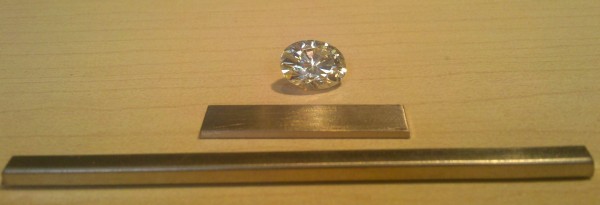

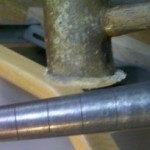

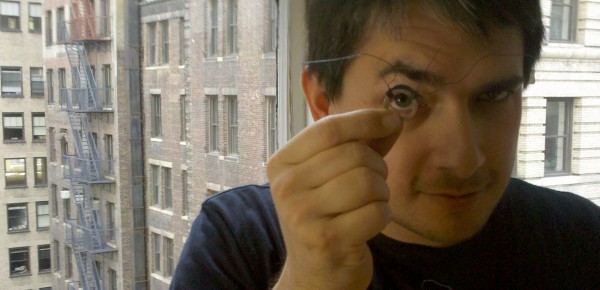
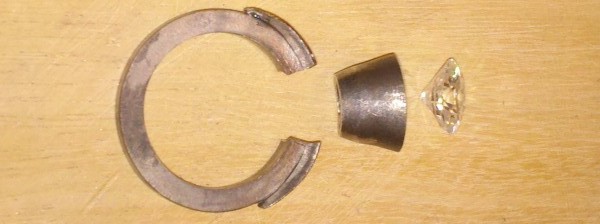

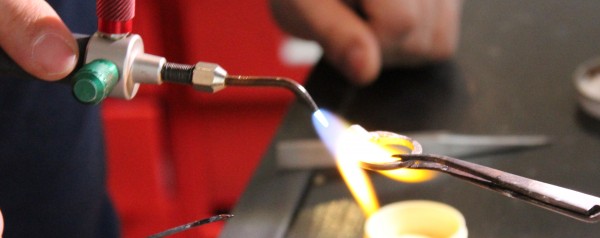
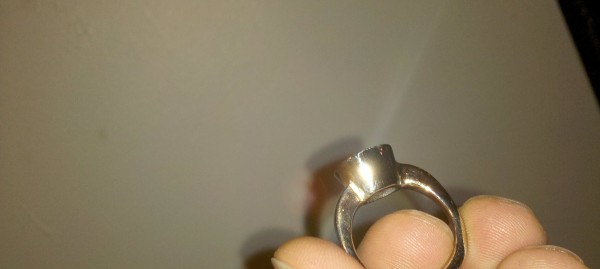
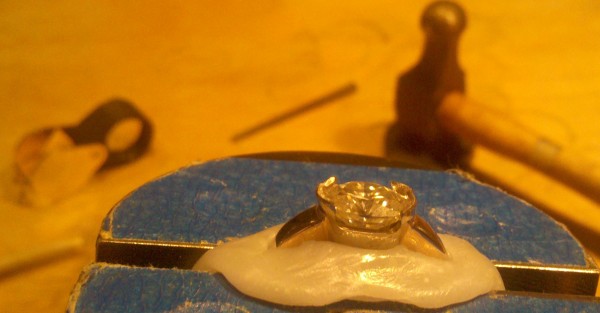







Superb, nice job. End result looks great. I attempted to do something similar but failed to find the right place to do it, and then made one out of origami instead. Which my mother-in-law accidentally recycled.
Beautiful.
Yeah, this is pretty much the epitome of awesome.
Wow Matt! Congratulations, in advance.
A couple things Matt. Firstly, for never being a jeweler, nice job. Secondly, Pickle is to remove oxidation and firescale, not flux. Flux would easily come off in an ultrasonic machine. A pickle pot can easily be made using a small crock pot. The more firescale you remove in pickle the less metal you file away. (All those shavings are very valuable) Thirdly, some files would probably speed your process. And most importantly, chisels around a stone are asking for trouble. Setting a stone is difficult enough for a beginner especially without using proper burs to seat it. I always used a prong pusher to set a stone the way you are. It had a handle to tap on, but it also had a very flat contact surface for the setting. Any piece of metal about the diameter of a pencil would work if you could tap on the top of it and the contact surface was smooth.
Oh, and one more thing, if you're buying gold solder already, make your life easier by buying hard and soft solders. That way you can solder the head in with hard solder, then solder the rose gold on with soft solder. There are more solders in between, but not really necessary in what you're showing. Like I said, nice job and hope I wasn't on a soapbox, I just hoped some extra tips would contribute.
Bill – all taken in the spirit you gave them. BTW – I had the excellent help of a jeweller in all of the steps. I didn’t know what I was doing and he guided me through all of it. Always easier when you’ve got smart folks with good experience guiding you.
I should really have made it clearer that this was done under guidance, I didn’t just figure it out.
Wow. That is amazing. That's kind of been my dream proposal idea, to make her the ring.
Great end result!
I tried to do something similar, but my goal was to cast a ring. No luck, I had problems with both the mold and with melting the metal. And that was just the brass testing, I didn't buy any gold yet.
Making the ring from a gold bar and solder is definitely a better idea for DIY.
Excellent step-by-step guide on making an engagement ring! Just imagine the look on her face when you get to tell her how much thought, time and energy you put into making her a ring.
Oh and think of the money you'll save too :) Of course it helps that you're using recycled white gold and Moissanite…
That is awesome! Great job and the end results are amazing.
wow. i want one of those.
This is awesome, it's a very informative and interesting tutorial.
Is it ok if I like to this from my blog?
Absolutely!! I’ve licensed everything on my site with a CC-BY-SA license, so you can even copy the post as long as you say it is by me and you give other people the same rights. And you NEVER need permission to link to something on the web – if it is on the web, it is public!
So romantic!!!
Brilliant! What a fantastic way to bring everlasting meaning to the ring she’ll wear forever!
Will this really take seven years to prepare? I’ve already met my future wife; can this be done in a year?
Took me forty-eight hours to prepare. I gave it to her seven years after I met her.
Wow! Very cool!